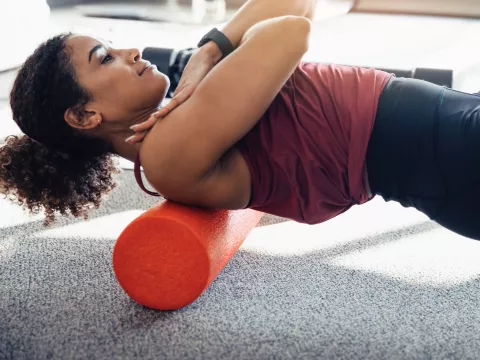- AdventHealth

It’s always best to view any new fad in sports with a watchful eye. If something seems too good to be true, it’s often because it is. But foam rolling may be one of the rare exceptions to the rule.
Although scientific research on the practice is still in early stages, the benefits of foam rolling seem to live up to the hype. Foam rolling has been shown to effectively reduce skeletal pain, improve circulation, increase range of motion and improve mobility — all for a very low cost or effort, making it particularly useful for runners.
Whether you love marathons, 5K runs or short jogs, foam rolling can help you make the most out of your mileage.
How Foam Rolling Works
Foam rolling is believed to cause self-myofascial release. To understand what this means, let’s breakdown the different components of this phrase.
“Myo” is a prefix that simply means muscle. The second part of the phrase — fascial — refers to fascia, a thin type of connective tissue that encloses, separates and stabilizes structures in the human body, including your muscles.
Several layers of fascia wrap around every muscle in the human body. When your fascia is functioning flawlessly, these layers slide by each other with ease, and your muscles feel loose and relaxed. However, injury, inactivity, inflammation and trauma can cause tangles to form in fascia, which can limit your range of motion and cause feelings of stiffness.
Myofascial release helps to smooth bunched up fascia, relieving tightness and allowing your muscles to separate and function better.
Benefits of Foam Rolling
If you’ve ever used a foam roller, you know that it can relieve pain much like a deep tissue or sports massage. Despite the mild discomfort it can involve, foam rolling provides a range of benefits, including:
- Better range of motion as adhesions decrease and fascia becomes more pliable
- Enhanced circulation from increased blood flow, especially in hard-to-reach extremities
- Reduced inflammation thanks to increased blood flow delivering more oxygen and nutrients to sore or injured areas
- Relaxation effects similar to a massage
- Removal of scar tissue or muscular adhesions from rolling chronically tight or painful areas, causing them to break down
Rolling the Right Way
Foam rolling is a fairly straightforward practice, but it’s easy to do it in a way that can damage your muscles. Following these tips can help ensure you stay safe and get the most out of your rolling session.
Do:
- Focus on calves, hamstrings, quads, hips and glutes —these areas respond best
- Hit all your target areas — work your way up, from your feet to your glutes, to hit key muscles, rolling the inner, outer and center of each
- Listen to your body — find the right pressure to loosen your fascia without exacerbating injured areas
- Roll after runs — rolling can be done anytime, but it’s most effective after a run
- Spend a short amount of time on each area — roll one to two minutes on each area
- Target above and below areas of soreness — areas of thick and irritated fascia, also called “trigger points,” are often above or below painful areas
Don’t:
- Continue if it’s painful — reduce pressure or work around an area if it hurts
- Roll across tendons, bones and sore areas — work around sore areas instead of directly on them
- Roll for too long on any one area — if you can’t get an area to loosen up, try two to three short sessions over the day instead of one long session
- Roll on an injured area — this will increase inflammation rather than reduce it
Choosing Your Roller
Rollers come in a variety of materials and shapes. If you’re new to rolling and aren’t convinced you’ll stick with using it, start with a simple roller made of condensed foam. While inexpensive, condensed foam rollers tend to soften and break down with regular use. Rollers with a rigid core are a cut above a basic foam roller, as they tend to last longer. Some are even made of more rigid materials for an intense, deep massage.
High-end rollers offer extra features, like vibration or the ability to be heated. These tend to be the most expensive options but can be a worthwhile investment for runners putting in a lot of miles.
Whole-Person Healing When You Need It
Sometimes, foam rolling isn’t enough to prevent or soothe an injury. But a setback doesn’t have to keep you from pounding the pavement. If you need help to support your health and fitness journey, our expert network of care is here to guide you with extra safety measures in place to protect your whole health.




